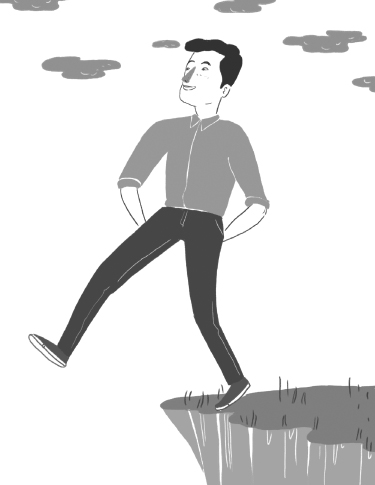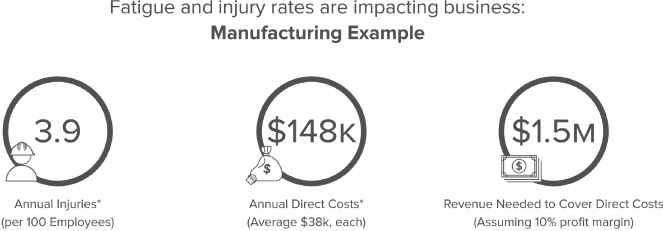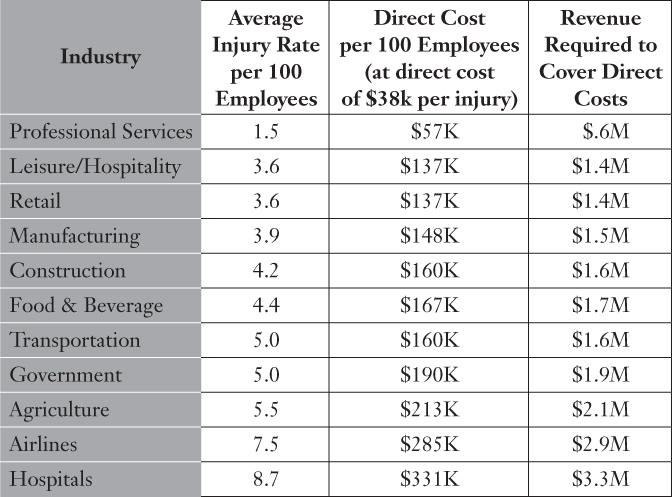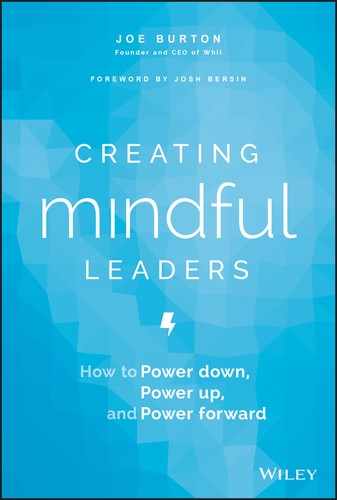
Chapter 11
Look, A Squirrel! Distraction and the Growing Safety Crisis
It is better to be careful 100 times than to get killed once.
—Mark Twain
Every day in America, 13 people go to work and never go home. Every year, 3.3 million suffer a workplace injury from which they may never recover.1
Safety isn't just a major issue at companies in manufacturing, construction, utilities, and oil & gas. Injury rates are up in every major sector. Even white‐collar companies are having a significant increase in on‐the‐job injuries. So what's causing it?
We already know that the average person spends about half of their time with the mind wandering. Researchers estimate that 90% of all workplace accidents are due to human error.2 Connecting the dots here isn't hard. When people don't pay attention, bad things can happen. And the stats are getting worse in just about every industry. It's become a crisis and ignoring it won't make it go away.
I've had the pleasure of speaking on the topic of safety at conferences around the world, including Mainstream, Best Practices for Oil & Gas, and SAP for Utilities. SAP for Utilities brings together the world's leaders in maintenance, reliability, and safety in industries like oil, gas, and power. I joined my good friend, Rudy Wolf, on stage for the utilities event to address 1,500 executives. Rudy heads the safety organization for Electric Transmission and Distribution Operations at Pacific Gas and Electric Company, a $15 billion annual energy company.
We were asked to speak on “leadership, stress, and safety.” As a driven perfectionist, it's a topic I know well. And as a COO inside of public companies, I'd driven my fair share of stress.
I accepted the invitation for two reasons. First, the opportunity to work with Rudy. He's an accomplished and inspiring leader. Second, speaking to an oil, gas, and utilities crowd about the role of mindfulness in the workplace kicked my judging mind into overdrive. Surely, the starting point for this crowd would be “Mindfulness training is a bunch of hippie bullsh*t.”
Yup. Check. Confirmed. The crowd was skeptical. That eased when Rudy and I got started. We both had a lot in common with the audience. Blue‐collar beginnings. Learning to ignore stress, work through pain, and do whatever we needed to in order to succeed. Humor, long hours, and tenacity were common weapons.
To connect with the skeptics, I shared that I was one. I had to jump three hurdles before trying mindfulness training. The first was data. I wanted the science. Second, I wasn't looking for a new religion. Third, who else was doing it? Even in my 40s, I still wanted to be with the cool kids.
I saw the science. I saw that a secular, pragmatic approach was possible. I saw that the top performance‐driven cultures were already embracing it, including professional athletes, universities, and Fortune 500 execs. I shared that studies have also shown that even four short sessions of meditation training reduced fatigue, anxiety, and significantly improved visuo‐spatial processing, working memory, and decision making.3 All important when it comes to safety. That went down well.
Rudy had the crowd from the word go. A tall, muscular, and imposing figure, he looks like he could pull a utility pole out of the ground and replant it across the street. Rudy's got a commanding presence and the crowd could tell he knew how to roll up his sleeves. He was one of them.
Injuries Don't Happen When You Think They Do
Rudy is a great storyteller and shared statistics from various industries. When it comes to utility companies, you might expect more worker injuries to occur in lightning and thunderstorms. Rudy shared that you'd be wrong, “Injury rates under dangerous weather circumstances are actually similar to normal working conditions. When workers know they are at risk for injury, they tend to be laser focused to ensure that doesn't happen. Surprisingly, just as many injuries happen on beautiful sunny days when workers don't have a care in the world. When it's just another day on the job, it's easy for the mind to wander into distraction. That's when people get hurt.” He called it the “blue sky effect.”
This is just one of the challenges that impacts safety. Most industries are facing increasing competition, cost pressures, increasing regulation, and the need to replace aging assets. Add to this maturing workforces and the difficulty in hiring young, skilled workers to service demanding consumers and you get increasing stress. It all feeds the more‐with‐less and faster, cheaper routines, which also impact employee stress and safety.
Traditional Solutions Aren't Enough
Industries have popped up to analyze the issues and help prevent injuries. Most companies have picked the low hanging fruit: training programs for workers, maintenance policies for equipment, machinery, tools, and technology to drive process improvement. Billions are spent on consultants and to address theories of accident causation models and map out correction plans to avoid future injury. Billions more on helmets, gloves, and special clothing. There's even a multibillion dollar signage industry reminding workers not to get hurt. Pithy signs like “Don't get hurt today!” “Watch out for the other guy,” and “Be alert! Expect the unexpected!” have their place and these traditional approaches are important. But all of these solutions and all the exclamation points on bright colored metal don't address the core issue. Most humans spend about half the time with their mind wandering and 90% of all accidents are caused by human error. We need to train people to improve their ability to focus.

The Numbers Add Up
Beyond employee health concerns, injuries also impact productivity. Rudy shared, “If your business has 10,000 employees and you increase productivity by 1%, that's the equivalent of adding 100 full‐time equivalents (FTEs), or about $20,000,000 annually. The opposite is also true if injuries cause you to lose 1% of productivity.”

Figure 11.2 The high cost of distraction.
Source: Occupational Safety and Health Administration, 2014.
When you dig into the statistics related to the cost of injuries, the numbers get big fast. Here's an example: according to the Occupational Safety and Health Administration (OSHA), if you're in the manufacturing sector, the average injury rate per every 100 employees is 3.9.4 You might think that 3.9% of people getting injured doesn't sound so bad. The national average in the United States is 3.2%. But here's the rub. U.S. businesses pay over $1 billion every week in direct injury costs (worker's compensation, medical, and legal expenses) with an average expense per injury of $38,000. For 3.9 injuries per year, you'd have $148,000 in injury‐related costs (3.9 × $38,000) for every 100 employees. This does not include indirect costs (lost productivity, hiring, and training replacements, investigations, and so forth), which are two to 10 times higher, depending on the type of injury.5
Now, let's assume you're in a 10% profit margin business. For every, $148,000 in costs, you'd need to make $1,480,000 in revenue ($148,000 / 10%) to make enough profit just to cover these expenses. Again, that's for every 100 employees. If you have 10,000 employees, multiple that by 100. If you have 100,000, multiply by 1,000. And if you're in a 5% margin business, double your numbers. It's a crisis.
I've shared a number of other industries in Figure 11.3. Unless your company has professionals that sit behind a desk all day, employee injuries have become a hot topic for good reason. Both the human and financial impacts are big and growing.

Figure 11.3 What's (left) in your wallet?
Source: OSHA, 2014, assumes $38,000 direct cost per injury.5
It's All Fun and Games Until Someone Gets Killed
These numbers always grab the crowd's attention. Then Rudy dropped the mic. He asked the audience the question, “How many of you have had to go to an employee's home to inform their spouse that they wouldn't be coming home?” As hands went up in the audience, more than a few teared up. Employees being injured or dying on the job have spiked in a lot of industries. Forget about innovation and transformation. That's disruption.
By the time we wrapped our talk, the crowd appreciated that mindfulness has also gone mainstream. Hearing that the last five Super Bowl champs and all five branches of the military also use mindfulness training to be “in the zone” and perform under pressure also resonated with the manly‐man crowd.
I Don't Need Mindfulness Training, But the Guy Next to Me Sure As Hell Does
During the evening social, I was struck by the openness of the attendees. Here were executives dedicated to the safety and reliability of the industrial plants and machinery that largely keep the world running. Their collective mission is to serve customers and protect their people. They operate in high‐stress industries where, if something goes wrong, communities are impacted and employees could be seriously injured or worse.
I used to find it easy to joke about oil & gas folks being fat, rich, and happy. I can now tell you that most are not. These are normal people, just like us, pushing the ball uphill in public companies. They work hard in highly competitive, stressful industries. Most were knee deep in R&D, investing in alternative energy solutions. Their future depends on it.
It doesn't matter how much you spend on the plant and equipment if the individual doesn't show up calm, focused, and in the right mind. They were surprisingly open about the elephant in the room. Despite their focus on the reliance and reliability of “assets,” there was an open recognition that they didn't focus on employee stress. It was accepted as a given. Over drinks that night, one executive lamented, “Man, do we need this. The stress on oil rigs is crazy. We lost two guys just last week. We're running teams into the ground with double shifts and no one seems to care. This is a dangerous business. It's not f*cking accounting.”
Later, a CEO of a well‐known utilities company summed it up over beers. “We could all use mindfulness training. It's a stressful business. Most of our guys probably think ‘I don't need attention training. But the guy next to me sure as hell does.'” We laughed. We worried. We drank. And his company is now a client.
Attention training helps employees concentrate better, be more situationally aware, react faster, stay on task longer, and retain more information. That means being more alert and aware of themselves, their co‐workers, and their surroundings. It's a skill that makes the billions invested in other safety solutions work better—an all‐natural performance enhancer.
Why Tough Guys Like Mindfulness Training
While we're on the topic of safety, I should address the misconception that practicing mindfulness is “for women” (or if you follow the recurring cover images of Time and Newsweek, healthy, fit white women). This simply isn't the case. Within our business, we cover millions of lives. The breakdown of male and female users is almost 50/50. These coping and resilience skills have countless benefits, no matter your gender, ethnicity, age, or profession.
In our experience, men enjoy digital mindfulness training better than attending typical coaching sessions or live training experiences. This is especially true for leaders when expectations run high.
There Are Several Reasons Why Men Like Digital Mindfulness Training
We Don't Have to Tell Anyone. Us guys fear all kinds of things. Failing. Looking bad. Having our masculinity challenged. Perhaps more than anything, we fear talking about our emotions. Remember that study about how men would rather go through electroshock therapy than sit alone with their own thoughts? It doesn't come easy to speak to our partner, our colleagues, or our boss about stress, anxiety, and our mental wellbeing in general.
We Can Fit It in Around Our Schedules. Mindfulness training offered up through a mobile device provides efficient and easy, on‐the‐go access for the busy, stressed‐out business executive. This provides the opportunity to step away, find a few minutes to reset. Whether it's on the train to work, before an important meeting or kicking off a dangerous job.
We Have Anger Management Issues. According to the American Psychological Association, more of us are dealing with “extreme stress” than ever.6 With that comes an increase in anger management issues. In fact, 37% of people reported being angry most of the time.7 Research shows that men have been conditioned to show their anger.8 However, when you're dealing with anger issues, it's hard to focus, let alone be a connected and empathetic leader. It's been said, “He who angers you conquers you.” Leaders can't afford that. With time, you'll find that you can manage anger more skillfully while experiencing it less frequently. Thanks neuroplasticity.
We Want to Win. Look, us guys are a competitive group. We like to be, look, and feel at our best. We like to believe we can be competitive no matter what the situation. As we age, sometimes it's hard to deal with the loss of our physical abilities and mental edge. But it doesn't have to be. Mindfulness not only makes us more resilient, it opens up deeper learning into a growth mindset, being less judgmental and more accepting (including of yourself).
It Helps Reduce Pain. In one study, just three days of brief mindfulness training was effective at reducing pain ratings and sensitivity and producing analgesic effects.9 When the topic comes to focus and performance, pain hurts our sleep, moods, and ability to focus. Sleep good. Pain bad.
It Ain't Therapy. All leaders could use a little help with our mental and emotional wellbeing. There's no shame in that. But for many, including myself, the idea of lying on a couch and pouring out our heart to a stranger just ain't happening. Of course, there's nothing wrong with therapy. But most men are looking to build coping skills that they can learn quickly and put to use immediately without an over‐reliance on others. We're fixers, so we like to be the ones with the solutions.
Myth dispelled. Leaders come in all shapes, sizes, and genders. So does the need for training and life skills to help us be at our best.
